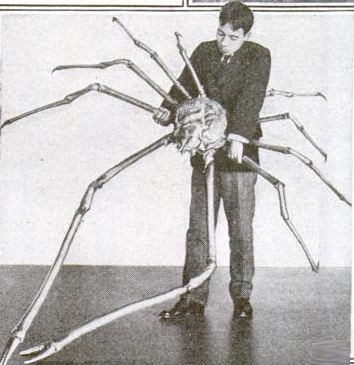400916-crabzilla.jpg

Japanese spider crab. Credit: Popular Science Magazine, June 1920.
Most of the crabs you find scuttling along the beach are a few inches to perhaps a foot or so across. But they have some relatives off the coast of Japan that are a bit more intimidating. In fact, they’ve been described as “crabzilla.” Spread out, their legs can span 13 feet, and the crabs can weigh up to 40 pounds. Not only does that make them the largest of all crabs, it makes them the largest of all arthropods — a class of creatures that includes everything from crabs and shrimp to scorpions and spiders.
The Japanese spider crab is found mainly on the Pacific Ocean side of a couple of Japanese islands. It’s generally found at depths of a few hundred feet, with juveniles closer to the surface, where it’s warmer, and full-grown adults in the colder depths.
Females lay up to one-and-a-half million eggs at a time. After they hatch, the larvae disperse into the water, where most are quickly eaten. Surviving juveniles often decorate their bodies with sponges, kelp, or other baubles to disguise themselves from predators. By the time they reach adulthood, though, they don’t have to worry about camouflage — their giant size deters most aggressors. Their hard-shelled bodies can reach a foot or more in length, while their legs can be up to about six feet long.
The spider crab eats mainly dead plants and animals on the ocean floor, although it sometimes eats living kelp or small animals. And if it avoids fishing nets, it can live a half-century or longer — taking giant steps near the islands of Japan.

